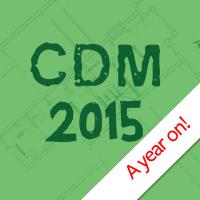 Add My Company
Add My Company
Sign In
CDM 2016? – a year on from CDM 2015
06-04-2016

CDM 2016? Are you as glad as us there isn’t one? After the big changes to CDM 2015 this time last year we’re glad to say there is no such thing as CDM 2016…sorry if we had you going!
We did however think we’d take a look at how CDM 2015 has made an impact on the industry, how builders and developers have felt about getting to grips with the changes and how health & safety software can make regulation issues a thing of the past.
The role of the Principal Designer
If you care to throw your mind back to the 6th April 2015, you may remember the biggest thing on everyone’s mind (other than a pension shake up and a mini heat wave) was the implications of CDM regulations removing the CDM Co-ordinator position and replacing it with the Principal Designer position.
This was in an attempt to place an emphasis on the design stage as a crucial phase in the health and safety consideration process. The Principal Designer (PD) position effectively combines the health and safety manager and technical designer positions in order to move away from a tedious ‘box ticking’ approach towards the target of health and safety being a key concern from the earliest part of the design process.
The result hasn’t necessarily been felt this way with many of the builders and developers that we have spoken to feeling this move was either ill-advised or that it has just meant the CDMC has simply taken on the new guise of PD with little to no change at all.
There has been high levels of confusion about who the role of PD applies to and what happens if the builder IS the PD. Joanna Mulgrew, product development director for Health & Safety Xpert 2016 (out now) says “the PD can be a designer, architect, consulting engineer, a quantity surveyor or anyone who specifies and alters designs as part of their work, which can include builders if they have been appointed to do so by the client and who have control over the pre-construction phase. In fact the builder can carry out more than one CDM duty holder role on a project. They must however have the skills, knowledge, experience and (if an organisation) the organisational capability to carry out all of the functions and responsibilities of each role in a way that secures health and safety”.
Approved Code of Practice
The issue of a lack of clarity has only worsened by the fact that the HSE had not brought out an Approved Code of Practice to support builders and developers through this stage until recently. Some have referred to this as “moving the goalposts without informing us where to”.
Continuing on from this analogy…we are happy to inform you of the benefits of Health & Safety Xpert, how it can save you these concerns and confusions and ultimately we won’t just show you where the goals are but we’ll set you up for a tap in too! Simply enter the details of your job and we’ll walk you through the rest. It’s genuinely as easy as that!
The implications of not adhering
Seeing as a year has gone past and the water isn’t much less muddy we are advising builders to seriously consider alternatives to understanding their roles and the implications for not adhering to them. Pleading ignorance isn’t going to cut it six months after the six month grace period has ended. Especially when you consider £609,312 of Fees for Intervention Invoices were issued in October 2015 alone. That’s not the sort of paper anniversary that anyone was hoping for.
Joanna said: “All builders have to make sure they are now fully up to speed or risk facing the scrutiny of the HSE, with possible fines, site shut down or even prosecution.”
The risks are even graver when you consider that 20 tradespeople die every week from asbestos related diseases and there were 35 construction related fatalities in 2014/15.
Construction Phase Plan (CPP)
One sector of the market that the new regulations has had an impact on is maintenance companies who are ‘rather disgruntled’ at the amount of additional paperwork that has been created for them. The issue is that any job, no matter how small, now requires a Construction Phase Plan (CPP).
Health & Safety Xpert 2016 (out now) can help turn those frowns upside down with the Simple Construction Phase Plan form (SCPP). Specifically designed for small jobs, the SCPP will save time and effort by being clear, concise and comprehensive.
Summary
Ultimately opinion on CDM 2015 is divided, but the feel from many is that it does not fulfil its original brief to reduce paperwork, and whilst improving the emphasis on pre-construction safety to help design out risks, the delay in release of the ACOP and thus far lack of amendments and improved clarity in the face of much industry feedback is just causing further confusion. In our view a software solution is the only solution.
For more information on CDM 2016? – a year on from CDM 2015 talk to HBXL
Enquire Now
List your company on FindTheNeedle.
